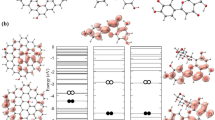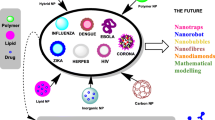Abstract
Graphene draws considerable attention among biomedical researchers because of its unique physical, chemical and biological properties. The wide applications of graphene in the biomedical arena such as diagnostics, drug immobilization and drug delivery were well documented in the literature. However the therapeutic potential of the graphene towards retroviruses and the interactions of the graphene with receptors/proteins are still unexplored. Herein we report the antagonistic molecular interactions of graphene with the three key target proteins of HIV infections namely HIVVpr, Nef and Gag proteins. The docking investigations were performed to find the binding energy of the graphene ligands to the key target proteins of HIV. The high binding affinity of the graphene to these proteins indicates the antagonistic molecular interaction of graphene to the disease targets. The therapeutic potential of graphene was also studied by changing the size and the number of layers of the graphene. The experimental results confirm the good therapeutic potential of the graphene to combat HIV mediated retroviral infections.
Similar content being viewed by others
References
L. Enomoto, P. L. Anderson, S. Li, C. L. Edelstein and A. Weinberg, AIDS Res Hum Retroviruses., 27, 47 (2011).
S. M. Arpadi, P. A. Cuff, M. Horlick, J. Wang and D. P. Kotler, J. Acquir. Immune Defic Syndr., 27, 30 (2001).
R. Navanietha Krishnaraj and S. Berchmans, RSC Adv., 3, 8953 (2013).
Y. Cheng, D. Li, B. Ji, X. Shi and H. Gao, J. Mol. Graph Model., 29, 171 (2010).
Y. Zhang, T. R. Nayak, H. Hong and W. Cai, Nanoscale., 4, 3833 (2012).
M. Bukrinsky and A. Adzhubei, Rev. Med. Virol., 9, 39 (1999).
L. Abraham and O. T. Fackler, Cell Commun., Signal, 10, 39 (2012).
N. M. Bell and A. M. Lever, Trends Microbiol., 21, 136 (2013).
M. Zhang, X. Mao, C. Wang, W. Zeng, C. Zhang, Z. Li, Y. Fang, Y. Yang, W. Liang and C. Wang, Biomaterials., 34, 1383 (2013).
X. Mao, Y. Wang, L. Liu, L. Niu, Y. Yang and C. Wang, Langmuir., 25, 8849 (2009).
L. Ou, Y. Luo and G. Wei, J. Phys. Chem. B., 115, 9813 (2011).
R. N. Krishnaraj, S. Chandran, P. Pal and S. Berchmans, Comb. Chem. High Throughput Screen., 16, 777 (2013).
R. N. Krishnaraj, S. Chandran, P. Pal and S. Berchmans, Comb. Chem. High Throughput Screen., (2014) [Epub ahead of print].
A. T. Laurie and R. M Jackson, Bioinformatics., 21, 1908 (2005).
O. Trott and A. J. Olson, J. Comput. Chem., 31, 455 (2010).
L.A. Emert-Sedlak, P. Narute, S. T. Shu, J.A. Poe, H. Shi, N. Yanamala, J. J. Alvarado, J. S. Lazo, J. I. Yeh, P. A. Johnston and T. E. Smithgall, Chem. Biol., 20, 82 (2013).
Author information
Authors and Affiliations
Corresponding author
Rights and permissions
About this article
Cite this article
Rathinam, N.K., Saravanan, C., Parimal, P. et al. Molecular interactions of graphene with HIV-Vpr, Nef and Gag proteins: A new approach for treating HIV infections. Korean J. Chem. Eng. 31, 744–747 (2014). https://doi.org/10.1007/s11814-014-0049-8
Received:
Accepted:
Published:
Issue Date:
DOI: https://doi.org/10.1007/s11814-014-0049-8




